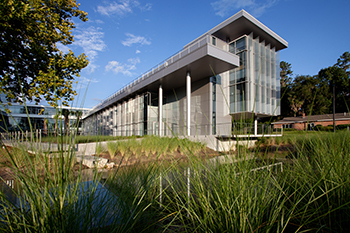UF Opens Clinical & Translational Research Building
 GAINESVILLE, Fla. — The University of Florida’s (UF) Clinical and Translational Research Building recently opened in Gainesville. The five-story, 120,000-square-foot building serves as the headquarters for the clinical and translational research at the university, as well as the state at large. The building houses the Clinical and Translational Science Institute and the UF Institute on Aging, as well as other research groups studying topics such as biostatistics, epidemiology, Muscular Dystrophy and Health Outcomes and Policy.
GAINESVILLE, Fla. — The University of Florida’s (UF) Clinical and Translational Research Building recently opened in Gainesville. The five-story, 120,000-square-foot building serves as the headquarters for the clinical and translational research at the university, as well as the state at large. The building houses the Clinical and Translational Science Institute and the UF Institute on Aging, as well as other research groups studying topics such as biostatistics, epidemiology, Muscular Dystrophy and Health Outcomes and Policy.
Perkins+Will’s Miami office served as the architect, while New York-headquartered Skanska served as the construction manager.
The new research facility is one of two like it in the country. It encourages collaborative study by incorporating three main components: health care, education and research. The design team worked with the university’s administration in order to fulfill the project goals such as creating environments that propel innovative, interdisciplinary research and discoveries; interfacing with the community through education; developing a space that is adaptable, flexible and modular; and providing a variety of indoor and outdoor interactive healing environments.
“The overall goal of the project was to create a building that would allow for the functions of translational research and allow for its flexibility along with its functions, meaning a building that would have to be ultimately configurable. It has a module-based design so that it can accommodate different kinds of needs regarding the Clinical and Translational Science Institute and how it relates to the Institute of Aging,” said Pat Bosch, LEED AP, design director with the Perkins+Will Miami office. “It was important to the client and to us that the building foster researchers’ goals of shortening the time from laboratory discovery to bedside treatment.”
The building was designed to achieve LEED Platinum, allowing the building to speak to the research being conducted inside. Natural elements heavily influenced the building’s design. For instance, a glass curtain wall reflects and refracts the area’s large amounts of sunlight. A solar photovoltaic system provides 8 percent to 12 percent of the building’s electricity. Rainwater is also collected to provide irrigation to the landscaping and to terrace planters, as well as to flush the latrines throughout the facilities. Displacement ventilation systems help keep the building cool while limiting the need for air conditioning.
“We learned a lot about the nature of translational research,” Bosch said. “You rarely get to have those three components merged into one. [The facility] is truly innovating by merging programs and disciplines and having the ability to allow for academia research and health care to all coexist and turn into this incubator of potential solutions to age old.”
The building’s location right next to an existing cogeneration plant posed acoustical challenges and vision challenges. The courtyard shields the building from the acoustics of the plant. The design team used strategies with glass and self-shading devices to help with those challenges. Skanska delivered successfully on time on budget, Bosch said.
“The Institute on Aging has always been dedicated to improving the health and preserving the independence of older adults and this wonderfully sustainable new facility will help that mission,” said Dr. Marco Pahor, director of the Institute on Aging, in a statement. “We are pleased that the IOA’s initial construction grant from the NIH has led to this multidisciplinary facility where researchers and clinicians from diverse fields can work together in an environment that promotes wellness.”
